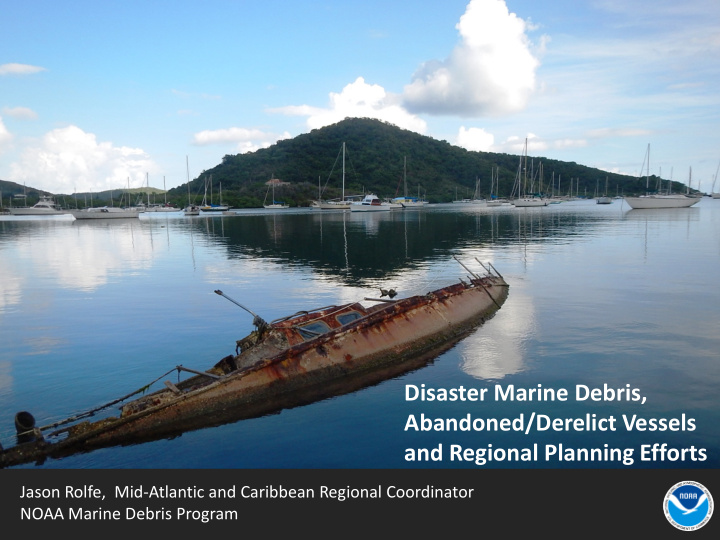



Disaster Marine Debris, Abandoned/Derelict Vessels and Regional Planning Efforts Jason Rolfe, Mid-Atlantic and Caribbean Regional Coordinator NOAA Marine Debris Program
Severe Marine Debris Events Marine Debris Program Reauthorized in December 2012 Marine Debris Act defines a “severe marine debris event” as “atypically large amounts of marine debris caused by a natural disaster, including a tsunami, flood, landslide, or hurricane, or other source.’’ (US Navy, March 15, 2011) Main Activities During Event Response: 1. Providing scientific support 2. Assisting in coordination 3. Communications and outreach
Every event is different… …and emergencies are often defined by the location of the event.
1. Scientific Support Shoreline Monitoring Marine Debris Monitoring and Assessment Project (US Navy, March 15, 2011)
1. Scientific Support Assessment • Marine debris probability model • Image comparisons • Shoreline assessments Surveying • Hydrographic surveys, LIDAR, digital imagery • Conducted by NOAA, academia and other federal and state agencies Analysis • Integrate debris survey data into ERMA • Prioritizing debris items for removal • Best management practices for debris removal in sensitive habitats
2. Coordination State-led Response Plans • Plans include rapid-response protocols; leverage state knowledge and capabilities • State partners take lead with support from various agencies, groups, and individuals • NOAA provides support and helps coordinate response efforts • West Coast states developed action plans for response to tsunami marine debris • Develop response plans for all coastal states using Alabama’s plan as framework
2. Coordination Alabama Plan Contents I. Background Risk: Foreseeable Incidents and Debris Types II. Agency Roles, Responsibilities, and Jurisdictions III. Permitting and Compliance Requirements IV. Gaps and Recommended Actions V. Agency Response Capabilities VI. Agency Contact Information Field Reference Guide
3. Communications and Outreach
Abandoned and Derelict Vessels Abandoned and Derelict Vessels (ADVs) are a hazard to navigation, degrade habitat, and are expensive to remove. Dog River, Alabama. Credit: Dauphin Island Sea Lab
ADV InfoHub components • Web Portal: – Centralized web-accessible “information hub” to assist state agencies in sharing information • Content creation and updates: – Library of ADV Literature – State legal summaries – 18 Regional case studies – Event-based case studies (i.e. How ADVs were addressed during Katrina) – List of state POCs and program links and information • Workshop – Stakeholders convened to provide input on InfoHub content and design
ADV InfoHub components
Marine Debris Reduction Planning Why Marine Debris Reduction Planning? • Coordinated efforts help reduce marine debris • NOAA MDP provides a roadmap – focused direction • Plan developed by local stakeholders adds value to issues and actions in the plan and becomes powerful tool to inform decision makers • Coordinated message among partners can be much more powerful communication tool • Helps us (NOAA MDP) prioritize projects for funding • Aligns states with regions, regions with Nation
Marine Debris Reduction Planning Existing Debris Reduction plans • Hawai’i Marine Debris Action Plan • Great Lakes Land Based Marine Debris Action Plan • VA Marine Debris Reduction Plan
Marine Debris Reduction Planning Plans Being Developed • SE Marine Debris Reduction Plan (NC, SC, GA) • FL Marine Debris Reduction Plan • Mid-Atlantic Marine Debris Reduction Plan (DE, MD, VA, DC) • Gulf of Maine Marine Debris Reduction Plan (NH, MA, ME) • Oregon Marine Debris Action Plan
Thank you!
Recommend
More recommend